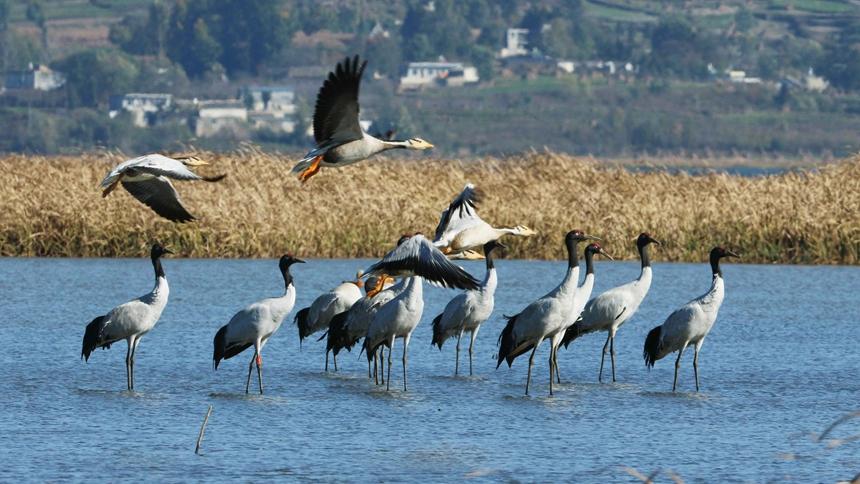China's panda national park fosters haven for biodiversity
CHENGDU, Nov. 26 (Xinhua) -- An infrared camera has recently captured an adult giant panda lingering in an artificial nest -- a positive sign indicating the possibility for the rare species to give birth in manmade nests.
The clip was collected in the Deyang part of the Giant Panda National Park in southwest China's Sichuan Province.
The small subpopulation of giant pandas in Deyang usually relies on tree holes and rock caves for breeding. As such natural sites were severely damaged in an earthquake in 2008, their reproduction was threatened. Therefore, since last year, conservationists have manually built 10 nests using tree trunks, bamboo branches, moss and other materials, placed infrared cameras inside and covered them with mud to mask human scents.
"Whether giant pandas will choose this location for breeding and giving births still needs further monitoring, but this video clip enhances our confidence in protecting small panda populations," said Zhao Weihong, deputy director of the Deyang branch bureau of the national park.

This image captured by an infrared camera in June 2024 shows an adult giant panda lingering in an artificial nest in the Deyang part of the Giant Panda National Park in southwest China's Sichuan Province. (Xinhua)
In 2021, China officially designated the first group of five national parks, including the Giant Panda National Park, which covers parts of the provinces of Sichuan, Shaanxi, and Gansu.
Speaking at the Global Panda Partners 2024 opening ceremony on Tuesday in Chengdu, Sichuan, Guan Zhiou, head of the National Forestry and Grassland Administration, said the country has established 67 giant panda nature reserves, forming a habitat protection system centered around the national park and achieving habitat connectivity and genetic exchange between 85 percent of the wild giant panda populations.
Themed "Harmonious Coexistence Between Man and Nature," the conference brings together government agencies, professionals and the general public as panda partners, calling on countries to join hands in protecting the living environments of pandas and other rare flora and fauna, and deepen cooperation and trust, as well as people-to-people exchanges and friendships.
According to Guan, the wild giant panda population has grown from around 1,100 in the 1980s to nearly 1,900, and the International Union for Conservation of Nature has downgraded the giant panda's status from endangered to vulnerable.
A BOOST FOR BIODIVERSITY
Through various measures such as constructing ecological corridors, digital monitoring and policy support, the national park has set up an example of boosting biodiversity and pursuing harmonious coexistence between man and nature.
According to Yang Zhisong, deputy head of the Sichuan Academy of Giant Panda, the fragmentation and isolation of the giant panda's habitats have led to 33 divided wild giant panda subpopulations, 25 of which are at risk of extinction due to their small numbers.
"Without the exchange of foreign genes, small subpopulations will lead to a decline in population vitality due to inbreeding and other factors. Therefore, we need to construct giant panda corridors to connect all subpopulations to increase the genetic diversity of wild giant pandas," said Yang.

Staff member Mu Shijie, dressed in a panda costume, feeds giant panda Xian Xian at the second-phase giant panda wild training fields of Tiantai Mountain in Wolong National Nature Reserve in southwest China's Sichuan Province, June 24, 2024. (Xinhua/Shen Bohan)
Since the inauguration of the national park, the Sichuan section of the national park, which accounts for 87.7 percent of its total 22,000-square-km area, has restored 8.03 square kilometers of key ecological corridor areas, chaining isolated "panda blocks" into a larger network. Measures taken include shutting down hydropower stations and minefields, restoring vegetation, and building a road tunnel to reduce the disturbance of highway traffic in the mountainous area.
Chen Zongqian, deputy director of the Sichuan provincial forestry and grassland bureau, said the construction of panda corridors not only benefits the giant pandas but also protects more than 8,000 other species of flora and fauna that coexist in their habitats.
"This is the 'umbrella effect' of the giant panda as a flagship species," said Chen.
After the national park was established, the number of giant pandas in key areas increased by 50, and the feces indicate that the habitat of giant pandas has expanded.
In the Chengdu area of the park, intelligent infrared cameras have been installed to help monitor giant pandas and other wild animals, using wireless network technology to transmit images in real time. This reduces human disturbance to the wildlife's habitats and allows monitoring staff to obtain the latest image data promptly, said Jiang Dongze, an informatization manager in the area.
The park has also pioneered the use of "panda face recognition" technology to achieve the wireless transmission of images and videos in real-time and compiled "DNA ID cards" for giant pandas.

Giant panda Xian Xian has a meal at the second-phase giant panda wild training fields of Tiantai Mountain in Wolong National Nature Reserve in southwest China's Sichuan Province, June 24, 2024. (Xinhua/Shen Bohan)
In terms of policy support, the three provinces of Sichuan, Shaanxi, and Gansu jointly issued a guideline on strengthening judicial protection of the national park in October 2023 and Sichuan Province has issued more than 30 documents and technical standards related to the construction of the national park.
HARMONIOUS COEXISTENCE
So far, the Sichuan section of the national park has provided over 3,100 public welfare positions for ecological protection.
Villager and ranger Hu Tailun in Yingjing County and his colleagues follow the monitoring team to patrol regularly, clean up hunting traps, dissuade villagers from digging bamboo shoots, and assist the monitoring staff in retrieving memory cards from infrared cameras.
He also runs a three-story homestay in his village, accommodating tourists and bird watchers. Such a life is quite different from decades ago when he followed his father to hunt and fell trees in the forests for a living.
"Unlike in the past when we hunted almost everything to fill our stomachs, I enjoy being a guide for bird watchers now. It brings me additional income and makes me happy," said Hu, 50.

A wild giant panda and her cub are pictured in the Giant Panda National Park in southwest China's Sichuan Province, April 2024. (Xinhua)
In case of damages caused by wild animals, the national park has fully covered insurance compensation for wildlife damage in 20 county-level regions in Sichuan, with a cumulative claim of over 14,000 cases and a total payout exceeding 8.11 million yuan (1.13 million U.S. dollars).
Rodolphe Delord, general director of Beauval ZooParc in France, said he was impressed by the Giant Panda national park after seeing all that is being done to safeguard and preserve this species in its natural habitat.
He said this is one of the most important conservation programs in the world and should serve as an example for species conservation internationally.
Commenting on China's national park system and its ecological conservation initiatives, Kirsten Griffiths Conrad, principal of the Singapore-based global wildlife conservation organization AsiaCat, remarked, "This is something that those of us involved in wildlife and ecological conservation can only dream of. When we care for wildlife and the environment, they, in turn, take care of us. These efforts highlight the interdependence between humanity and nature."
(Xinhua correspondents Cao Peixian and Zhao Yining contributed to the story.)?
Photos
Related Stories
Copyright © 2024 People's Daily Online. All Rights Reserved.









